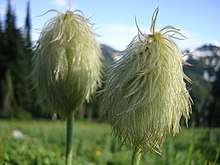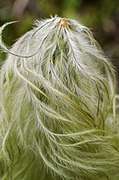Anemone occidentalis
Anemone occidentalis, the white pasqueflower[1] or western pasqueflower, is a herbaceous plant species in the genus Anemone and family Ranunculaceae. Other authorities place it in the genus Pulsatilla. Individuals are 10–60 cm (3.9–23.6 in) tall, from caudices, with three to six leaves at the base of the plant that are 3-foliolate, each leaflet pinnatifid to dissected in shape. Leaf petioles are 6–10 cm (2.4–3.9 in) long. Leaves have villous hairs and their margins are pinnatifid or dissected. Plants flower briefly mid-spring to mid-summer, usually soon after the ground is exposed by melting snow. The flowers are composed of five to seven sepals (sometimes called tepals), normally white or soft purple, also mixed white and blueish purple, one flower per stem. The sepals are 15–30 mm (0.59–1.18 in) long and 10–17 mm (0.39–0.67 in) wide. Flowers have 150–200 stamens. The fruit occurs in heads rounded to subcylindric in shape, with pedicels 15–20 cm (5.9–7.9 in) long. The achenes are ellipsoid in shape, not winged, covered with villous hairs, with beaks curved that reflex as they age and 20–40 mm (0.79–1.57 in) long, feather-like. Generally, the fruit persists into fall.
| Anemone occidentalis | |
|---|---|
 | |
| Anemone occidentalis achene | |
| Scientific classification | |
| Kingdom: | Plantae |
| Clade: | Tracheophytes |
| Clade: | Angiosperms |
| Clade: | Eudicots |
| Order: | Ranunculales |
| Family: | Ranunculaceae |
| Genus: | Anemone |
| Species: | A. occidentalis |
| Binomial name | |
| Anemone occidentalis | |
| Synonyms | |
|
Pulsatilla occidentalis (S. Watson) Freyn | |
Native to far western North America including British Columbia to California and Montana, it is found growing in gravelly soils on slopes and in moist meadows.[2]
Chemistry
Western pasqueflower likely contains ranunculin and protoanemonin, an irritant glycoside and its aglycone, as these are seen in most members of this genus and the plant's latex is irritating.[3] It can be fatal to domestic animals, particularly to sheep, and should thus not be eaten by humans.[4]
Traditional medicine
The fresh stems and seeds of the plant are used traditionally in North America as analgesics, anxiolytics, and sedatives.[5]
Landmarks
Pulsatilla Pass in Banff National Park is named after this species.[6]
Image gallery
 Anemone occidentalis in Kootenay National Park, Canada
Anemone occidentalis in Kootenay National Park, Canada.jpg) Anemone occidentalis flower
Anemone occidentalis flower.jpg) Anemone occidentalis on Mount Rainier with some achenes cut away to show the receptacle and seeds.
Anemone occidentalis on Mount Rainier with some achenes cut away to show the receptacle and seeds.- The persistent achene and foliage are distinguishing features.
References
- "Pulsatilla occidentalis". Natural Resources Conservation Service PLANTS Database. USDA. Retrieved 16 October 2015.
- Flora of North America Vol 3, Magnoliophyta:Magnoliidae and Hamamelidae. Flora of North America Editorial Committee. Oxford University Press. 1997. pp. 139–158. ISBN 0-19-511246-6.CS1 maint: others (link)
- Hao DC, Gua XJ, Xiao PG (2017). "Anemone medicinal plants: ethnopharmacology, phytochemistry and biology". Acta Pharmaceutica Sinica B. 7 (2): 146–158. doi:10.1016/j.apsb.2016.12.001. PMC 5343163. PMID 28303220.
- Reiner, Ralph E. (1969). Introducing the Flowering Beauty of Glacier National Park and the Majestic High Rockies. Glacier Park, Inc. p. 28.
- Moore, Michael (1993). Medicinal Plants of the Pacific West. Santa Fe, NM: Red Crane Books. p. 257. ISBN 9780890135396.
- "Archived copy". Archived from the original on 2015-09-19. Retrieved 2017-08-17.CS1 maint: archived copy as title (link)
External links
| Wikimedia Commons has media related to Anemone occidentalis. |
| Wikispecies has information related to Anemone occidentalis |